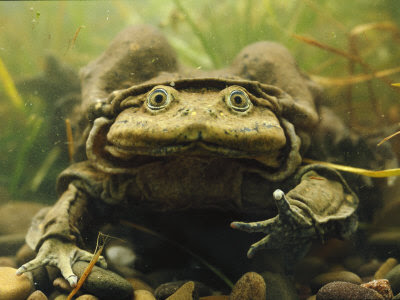Lake Titicaca is the highest navigable lake in the world,
and with an area of more than 8,300 sq. km, it is also very large. Due to the
great altitude at which this lake is found, the oxygen levels in its waters are
very low, so low in fact that some of the animals living in this lake have
evolved some remarkable adaptations. Most famous of all the lake's inhabitants
is the Lake Titicaca frog, an amphibian that is found only in this lake and
only in its shallower reaches. As frogs go, the Lake Titicaca variety is quite
a specimen. There are reports of adult frogs measuring more than 50 cm long,
tipping the scales at more than 1 kg. In many respects, the Lake Titicaca frog
is much like any other frog. It has a squat body, a wide head, and
well-developed hind limbs with webbed digits. What is unusual about this animal
is its skin. Its covering is a loose, baggy affair, and around the abdomen, legs,
stomach, and neck, the flaccid skin falls into folds giving the animal a rather
unsavory appearance. When it was first discovered by two adventurers during an
1876 expedition, it was labeled with the Latin name Telmatobius coleus. This
translates as "aquatic scrotum" and is a tongue-in-cheek description
of its appearance. As unsightly as it may be, the Lake Titicaca frog is
perfectly suited to life in the oxygen-deficient waters of the lake. It rarely
breathes using its lungs but gets most of the oxygen it needs via diffusion
across the moist surface of its skin. The wrinkling and creasing of its
covering greatly increases the surface area available for diffusion, allowing
the animal to make the very most of the limited quantity of life-giving oxygen
dissolved in the water. With the oxygen diff using into its body and the carbon
dioxide heading out into the water, the frog also requires an efficient means
for the transport of these gases. The red blood cells tumbling through the
amphibians vessels are the smallest of all the amphibians, and they contain the
most hemoglobin. As these smaller cells with their oxygen gripping hemoglobin
can be more tightly packed within the veins and arteries, sufficient oxygen can
be shunted around the body to supply the animal's demands.

No comments:
Post a Comment